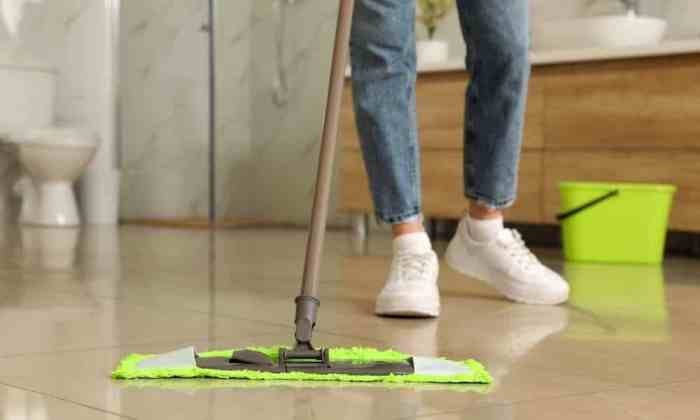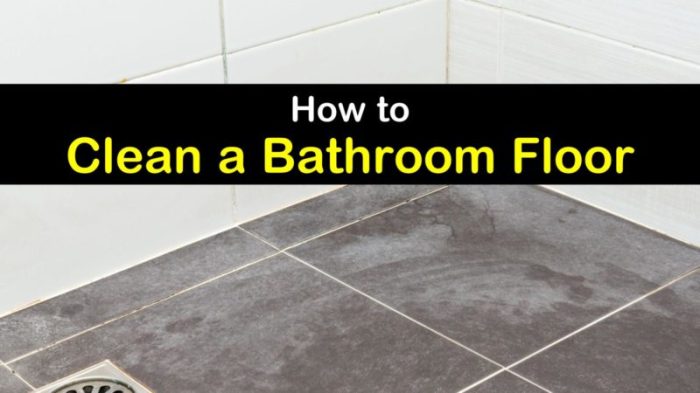Maintaining a pristine bathroom is a crucial aspect of home hygiene and aesthetics. The flooring, being a significant surface area, plays a pivotal role in determining the overall cleanliness and ease of maintenance. This comprehensive guide delves into the world of easy-to-clean bathroom flooring solutions, empowering you with the knowledge and insights to create a bathroom that is both stylish and effortlessly hygienic.
From exploring durable and water-resistant materials to discussing low-maintenance options, grout and joint management, and non-slip safety considerations, this guide covers every aspect of bathroom flooring. We will also delve into innovative cleaning solutions and design considerations to help you achieve a bathroom that is not only easy to clean but also aesthetically pleasing.
Durable and Water-Resistant Flooring Materials
When choosing flooring for bathrooms, durability and water resistance are crucial considerations. Water-resistant materials protect against moisture damage, while durable materials withstand heavy foot traffic and daily wear and tear.
Porcelain Tiles
Porcelain tiles are a classic choice for bathrooms due to their exceptional durability and water resistance. They are made from a dense clay body that is fired at high temperatures, resulting in a non-porous surface that repels water. Porcelain tiles are also resistant to scratches, stains, and fading, making them a low-maintenance option.
Vinyl Flooring
Vinyl flooring is a versatile and affordable option that offers both durability and water resistance. It is made from synthetic materials that are moisture-proof and resistant to wear and tear. Vinyl flooring comes in a wide range of styles, including realistic wood and stone looks, making it a suitable choice for any bathroom décor.
Laminate Flooring
Laminate flooring is a budget-friendly option that mimics the look of hardwood flooring. It consists of a high-density fiberboard core with a decorative top layer and a protective wear layer. While laminate flooring is not as water-resistant as porcelain or vinyl, it can withstand occasional spills and moisture.
However, it is important to avoid prolonged exposure to water to prevent damage.
Low-Maintenance Flooring Options
Maintaining a clean bathroom floor can be a hassle, but choosing the right flooring material can make it a breeze. Look for options that are stain-resistant, scratch-resistant, and slip-resistant to minimize cleaning effort and maintain a pristine appearance.
Stain Resistance
Stains can be a nightmare to remove, especially in high-traffic areas like bathrooms. Opt for flooring materials that are non-porous and resistant to common household stains, such as ceramic tiles, luxury vinyl tiles (LVT), or epoxy flooring.
Scratch Resistance
Heavy foot traffic and sharp objects can easily scratch and damage flooring surfaces. Choose flooring materials with a high Mohs hardness rating, which indicates their resistance to scratching. Ceramic tiles, LVT, and epoxy flooring are all highly scratch-resistant options.
Slip Resistance
Slippery bathroom floors can be dangerous, especially when wet. Ensure your flooring material has a high coefficient of friction (COF) to provide good traction and prevent slips and falls. Ceramic tiles with a textured surface, LVT with a non-slip backing, or epoxy flooring with added anti-slip additives are all excellent choices for slip resistance.
Grout and Joint Management
Keeping grout and joints clean in bathrooms can be challenging due to moisture, soap scum, and mildew buildup. Regular cleaning is crucial to prevent staining and damage.Different grout options impact cleaning ease:
Epoxy grout
Stain-resistant and easy to clean, but more expensive and requires professional installation.
Sanded grout
More porous, requiring frequent cleaning and sealing to prevent stains.
Unsanded grout
Smoother surface, making it easier to clean, but may crack or discolor over time.Regular cleaning with a mild cleaner and soft brush helps remove dirt and grime. Sealing grout annually protects it from stains and moisture. Repairing cracks or damaged joints with a grout repair kit is essential to prevent further damage.
Non-Slip and Safe Flooring
Bathrooms are inherently prone to moisture and spills, making non-slip flooring a crucial safety consideration. Accidents can occur when surfaces become wet and slippery, especially for individuals with limited mobility or seniors.
Various types of non-slip flooring surfaces are available to enhance safety in bathrooms:
Textured Tiles
- Tiles with textured surfaces provide increased friction, reducing the risk of slipping.
- Consider tiles with a matte or unglazed finish, as they offer better grip compared to glossy tiles.
- Tiles with raised patterns or grooves further enhance traction, making them ideal for shower areas and bathroom entrances.
Rubber Flooring
- Rubber flooring is naturally slip-resistant due to its inherent elasticity.
- It provides a soft and comfortable surface, making it suitable for areas where people may stand for extended periods.
- Rubber flooring is also durable and water-resistant, making it a practical choice for bathrooms.
Anti-Slip Coatings
- Anti-slip coatings can be applied to existing flooring surfaces to enhance their slip resistance.
- These coatings are available in various forms, such as paints, sprays, or adhesives.
- When selecting an anti-slip coating, consider its durability, ease of application, and compatibility with the existing flooring material.
When choosing non-slip flooring materials, it is important to consider both safety and ease of cleaning. Textured tiles and rubber flooring are generally easy to clean with regular sweeping and mopping. Anti-slip coatings may require specific cleaning methods to maintain their effectiveness.
Easy-to-Clean Accessories and Fixtures
Maintaining a clean bathroom is essential for hygiene and aesthetics. Selecting the right accessories and fixtures can significantly simplify cleaning tasks.
Consider touchless faucets that activate with motion, reducing the spread of germs. Self-cleaning toilets utilize electrolysis to minimize stains and odors. Frameless shower doors eliminate crevices where mold and mildew accumulate.
Hardware and Fixture Selection
- Choose hardware with smooth surfaces to prevent dirt buildup.
- Opt for fixtures with rounded corners to reduce the risk of dust and grime accumulation.
- Consider using antibacterial or antimicrobial materials to inhibit bacteria growth.
Innovative Cleaning Solutions
Bathrooms demand specialized cleaning approaches to maintain hygiene and aesthetics. This section explores innovative cleaning solutions and techniques designed to simplify bathroom flooring maintenance.
Specialized cleaning products formulated for bathroom surfaces effectively remove dirt, grime, and soap scum. Microfiber mops excel at trapping dirt and moisture, while steam cleaners harness the power of steam to sanitize and deep clean.
Effective Cleaning Methods
Regular maintenance is crucial for keeping bathroom floors spotless. Use a microfiber mop or damp cloth to wipe down floors daily, removing loose dirt and debris. Deep cleaning, performed weekly or bi-weekly, involves using specialized cleaning products and scrubbing with a brush or mop to remove stubborn stains and grime.
For tough stains, spot cleaning with a concentrated cleaning solution or a baking soda paste can effectively remove discoloration. Rinse thoroughly with water after cleaning to prevent residue buildup.
Design Considerations for Easy Cleaning
Bathroom design can significantly impact the ease of cleaning and maintenance. By incorporating certain design elements, you can create a bathroom that is both aesthetically pleasing and effortless to keep clean.
One key consideration is the use of large-format tiles. Larger tiles mean fewer grout lines, which are notoriously difficult to clean and can harbor mold and mildew. Grout lines also tend to discolor over time, making them even more unsightly.
By minimizing grout lines, you can significantly reduce the time and effort required to clean your bathroom.
Incorporating Built-in Storage Solutions
Another important design element is the incorporation of built-in storage solutions. By providing ample storage space, you can keep your bathroom clutter-free and organized. This makes it much easier to clean, as you won’t have to move around a lot of items or deal with clutter.
Finally, consider the overall layout of your bathroom. A well-designed bathroom will have a logical flow that makes it easy to move around and access all areas. This will make cleaning more efficient and less time-consuming.
Closing Summary
In conclusion, creating a bathroom with easy-to-clean flooring is a combination of choosing the right materials, implementing effective cleaning techniques, and incorporating thoughtful design elements. By following the guidance Artikeld in this comprehensive guide, you can transform your bathroom into a haven of cleanliness and style, where maintaining a pristine environment is a breeze.
Remember, a well-maintained bathroom not only enhances your daily routine but also contributes to the overall well-being and value of your home.



